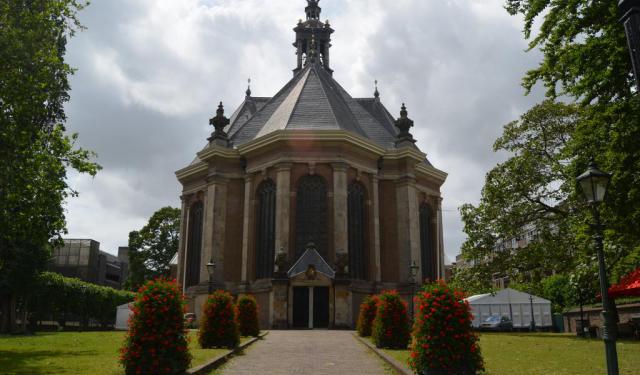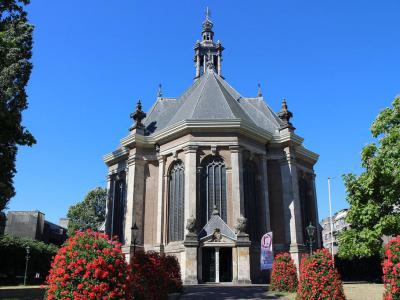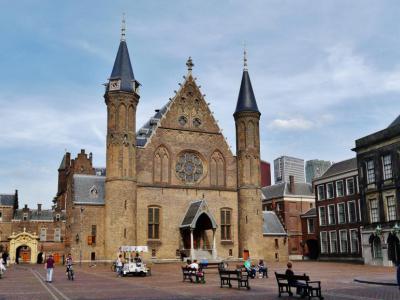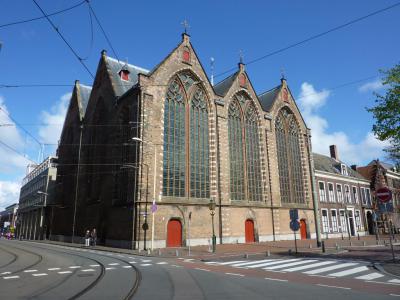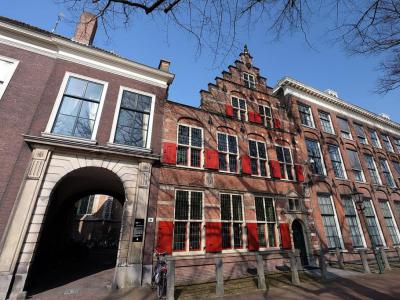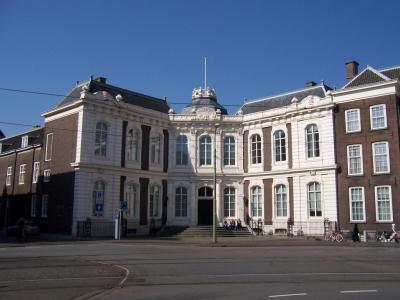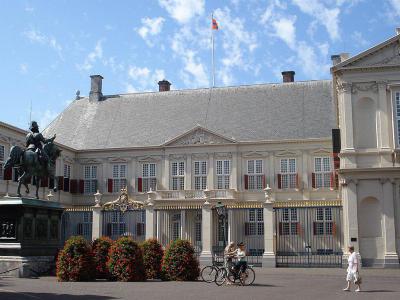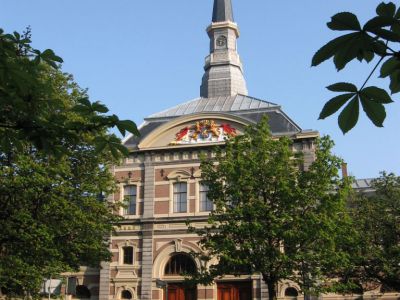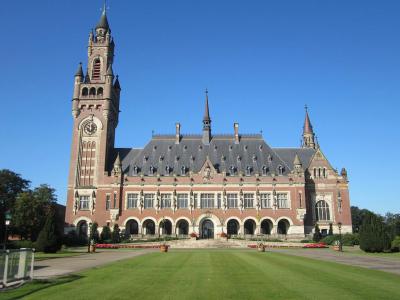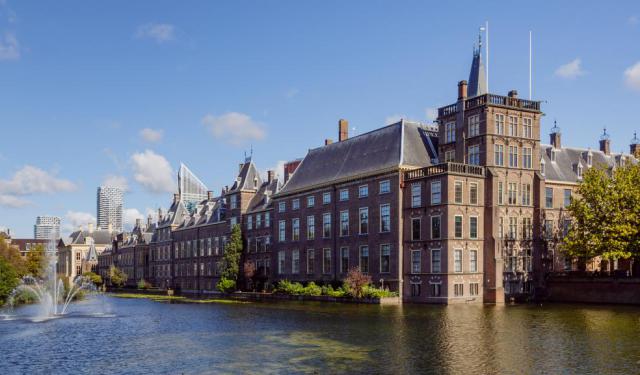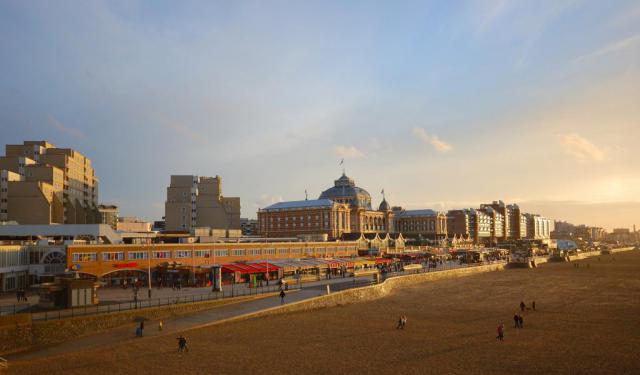Hague's Classic Architectural Jewels (Self Guided), Hague
As the third largest metropolis in the Netherlands, The Hague has plenty to offer architecturally discerning travelers. The city is a living proof of a harmonious coexistence between a modern, easy on the eye skyline and a steeped in history downtown. Owing to its fascinating (political) past, The Hague has a plethora of historic buildings associated with worship, governance, royalty and international legal affairs.
A good number of them date back as far as the feudal period, and, in keeping with the Dutch tradition, are set by the river or canal, which also adds to their beauty. In The Hague, there are buildings that broke new ground in Dutch history – some for their social and political context, others for their visual aesthetics or royal status.
Whether you are an art lover, architecture buff or simply fascinated by The Hague’s role as an international judicial center, you will find plenty of interesting buildings, be it medieval churches or royal palaces, on any given day out there. Here are a few fascinating ones:
Ridderzaal (Knight's Hall) – used mainly for festive gettogethers by the Counts of Holland; once a year, on Prinsjesdag (Prince's Day), the Dutch Sovereign rides to the Hall in the Golden Coach to deliver a throne speech.
Mennonite Church – one of the few Neo-Romanesque churches in The Hague.
Paleis Noordeinde (Noordeinde Palace) – the headquarters of King Willem-Alexander; one of the three palaces used by the Dutch Royal Family.
Vredespaleis (Peace Palace) – seat of many legal organizations, including the International Court of Justice, aka the World Court.
If you wish to discover the distinctive streetscape of The Hague and explore some of the most impressive, centuries-old buildings that make up the city's fabric in more detail, embark on this self-guided journey!
A good number of them date back as far as the feudal period, and, in keeping with the Dutch tradition, are set by the river or canal, which also adds to their beauty. In The Hague, there are buildings that broke new ground in Dutch history – some for their social and political context, others for their visual aesthetics or royal status.
Whether you are an art lover, architecture buff or simply fascinated by The Hague’s role as an international judicial center, you will find plenty of interesting buildings, be it medieval churches or royal palaces, on any given day out there. Here are a few fascinating ones:
Ridderzaal (Knight's Hall) – used mainly for festive gettogethers by the Counts of Holland; once a year, on Prinsjesdag (Prince's Day), the Dutch Sovereign rides to the Hall in the Golden Coach to deliver a throne speech.
Mennonite Church – one of the few Neo-Romanesque churches in The Hague.
Paleis Noordeinde (Noordeinde Palace) – the headquarters of King Willem-Alexander; one of the three palaces used by the Dutch Royal Family.
Vredespaleis (Peace Palace) – seat of many legal organizations, including the International Court of Justice, aka the World Court.
If you wish to discover the distinctive streetscape of The Hague and explore some of the most impressive, centuries-old buildings that make up the city's fabric in more detail, embark on this self-guided journey!
How it works: Download the app "GPSmyCity: Walks in 1K+ Cities" from Apple App Store or Google Play Store to your mobile phone or tablet. The app turns your mobile device into a personal tour guide and its built-in GPS navigation functions guide you from one tour stop to next. The app works offline, so no data plan is needed when traveling abroad.
Hague's Classic Architectural Jewels Map
Guide Name: Hague's Classic Architectural Jewels
Guide Location: Netherlands » Hague (See other walking tours in Hague)
Guide Type: Self-guided Walking Tour (Sightseeing)
# of Attractions: 9
Tour Duration: 2 Hour(s)
Travel Distance: 2.9 Km or 1.8 Miles
Author: valery
Sight(s) Featured in This Guide:
Guide Location: Netherlands » Hague (See other walking tours in Hague)
Guide Type: Self-guided Walking Tour (Sightseeing)
# of Attractions: 9
Tour Duration: 2 Hour(s)
Travel Distance: 2.9 Km or 1.8 Miles
Author: valery
Sight(s) Featured in This Guide:
- Nieuwe Kerk (New Church)
- Ridderzaal (Knight's Hall)
- Kloosterkerk (Monastery Church)
- Pageshuis (Pages' House)
- Kneuterdijk Palace
- Paleiskerk (Palace Church)/Mennonite Church
- Paleis Noordeinde (Noordeinde Palace)
- Koninklijke Stallen (Royal Stables)
- Vredespaleis (Peace Palace)
1) Nieuwe Kerk (New Church)
The New Church in The Hague (Nieuwe Kerk) is a Protestant Dutch Baroque temple. Its construction began in 1648, during the time of the Protestant conquest in The Netherlands, and was completed in 1656. The unique design, created by the architect Pieter Noorwits, is considered a notable example of early Dutch Protestant church architecture. Unlike most Protestant churches of that era, which had a rounded floor plan, Noorwits designed the New Church with two octagonal areas connected by a slightly smaller section where the pulpit was placed, following the Protestant principle of centralization. This design incorporates elements of both the Renaissance and Classicism architectural styles.
The church features two bells, one with a diameter of 100.2 centimeters and the other with a diameter of 81.5 centimeters, both cast in 1656 by Coenraat Wegewaert, who also designed the church's clock. Another noteworthy aspect is the organ, constructed by the Dutch master Johannes Duyschot in 1702, which was later modified in 1867 to accommodate more modern Romantic music.
During the 20th century, various adjustments were made to improve the acoustics of the interior. In 1969, the building underwent an extensive renovation and was reopened as a concert hall.
In the past, the New Church was primarily accessible by boat until the end of the 19th century when the canals surrounding the site were filled in.
Among the notable figures buried in the New Church is the 17th-century Dutch philosopher Baruch Spinoza.
The church features two bells, one with a diameter of 100.2 centimeters and the other with a diameter of 81.5 centimeters, both cast in 1656 by Coenraat Wegewaert, who also designed the church's clock. Another noteworthy aspect is the organ, constructed by the Dutch master Johannes Duyschot in 1702, which was later modified in 1867 to accommodate more modern Romantic music.
During the 20th century, various adjustments were made to improve the acoustics of the interior. In 1969, the building underwent an extensive renovation and was reopened as a concert hall.
In the past, the New Church was primarily accessible by boat until the end of the 19th century when the canals surrounding the site were filled in.
Among the notable figures buried in the New Church is the 17th-century Dutch philosopher Baruch Spinoza.
2) Ridderzaal (Knight's Hall) (must see)
Once a year on Prinsjesdag, the Sovereign of the Netherlands rides in a Golden Coach all the way to the Knight's Hall to sit on the Throne and deliver a speech. The Knight's Hall was built by William II, King of the Romans and son of Floris IV of Holland. William died in battle in 1256 but the Knight's Hall was completed by his son, Floris V.
The Hall was used mainly for festive gettogethers by the Counts of Holland. In the 17th and 18th centuries it was used as a storage space and office of the state lottery. By the 19th century the building was in a state of ruin. In 1904 the building was restored in the Gothic style. The interior was designed by Pierre Cuypers.
Lately the Knight's Hall has been the venue for the State Opening of Parliament, the Speech from the Throne on Prinsjesdag, and for receptions and conferences. The government held a celebratory dinner there in honor of Queen Beatrix at her Silver Jubilee. The Hall has also been the venue for Royal Weddings and similar observances.
The Knight's Hall is administered by the Government Buildings Agency. Guided tours are given by the visitors' center of the ProDemos Centre for Democracy and the Rule of Law.
Editor's Note: The Knight's Hall is closed for extensive renovations until at least 2030, as part of the ongoing restoration of the Binnenhof complex. Visitors can still view the site from the free yellow observation tower and learn more at the Binnenhof Renovation Information Centre.
The Hall was used mainly for festive gettogethers by the Counts of Holland. In the 17th and 18th centuries it was used as a storage space and office of the state lottery. By the 19th century the building was in a state of ruin. In 1904 the building was restored in the Gothic style. The interior was designed by Pierre Cuypers.
Lately the Knight's Hall has been the venue for the State Opening of Parliament, the Speech from the Throne on Prinsjesdag, and for receptions and conferences. The government held a celebratory dinner there in honor of Queen Beatrix at her Silver Jubilee. The Hall has also been the venue for Royal Weddings and similar observances.
The Knight's Hall is administered by the Government Buildings Agency. Guided tours are given by the visitors' center of the ProDemos Centre for Democracy and the Rule of Law.
Editor's Note: The Knight's Hall is closed for extensive renovations until at least 2030, as part of the ongoing restoration of the Binnenhof complex. Visitors can still view the site from the free yellow observation tower and learn more at the Binnenhof Renovation Information Centre.
3) Kloosterkerk (Monastery Church)
The history of the Monastery Church (Kloosterkerk) dates back to the late 14th century. In 1393, the land where it now stands was granted to the Amsterdam Saint Andrew Monastery, which subsequently sold it to the Dominican Order just a year later. The Dominicans then proceeded to construct their own monastery on the site, complete with a church, in 1397.
In 1420, the church miraculously survived a devastating fire, and by 1540, it had undergone expansion with the addition of a larger aisle and side chapels. However, during the Beeldenstorm, a wave of iconoclasm in 1566, the church was stripped of its Catholic adornments, and only a few friars remained on the premises until 1574. In 1583, most of the monastery was dismantled, but the church endured. It was left abandoned and in a state of decay for 12 years, nearly facing demolition.
Subsequently, the building took on various roles, serving as a shelter for a cavalry company, a cannon foundry, and a storage facility for munitions. In 1617, it was partially restored for religious purposes. Unfortunately, on November 3, 1690, a munitions explosion destroyed everything except for a single wall.
In 1691, King William III of England visited the Monastery Church, and in 1813, it briefly hosted a regiment of Russian Cossacks. Religious services fully resumed in 1914, only to be interrupted again during the German occupation of the Netherlands in World War II, from May 1940 to 1942.
Between 1952 and 1957, the church underwent extensive renovation, including the removal of a wall separating the nave and the choir. In 1997, King Willem-Alexander confessed in the Monastery Church, and in 2007, Princess Ariane was baptized here. Former Queen Beatrix also occasionally attends services.
In 2002, a memorial plaque was unveiled in honor of Daniel Gabriel Fahrenheit, a physicist and inventor born in Danzig (Gdansk) during the 17th-18th century. He is buried at the Monastery Church.
In 1420, the church miraculously survived a devastating fire, and by 1540, it had undergone expansion with the addition of a larger aisle and side chapels. However, during the Beeldenstorm, a wave of iconoclasm in 1566, the church was stripped of its Catholic adornments, and only a few friars remained on the premises until 1574. In 1583, most of the monastery was dismantled, but the church endured. It was left abandoned and in a state of decay for 12 years, nearly facing demolition.
Subsequently, the building took on various roles, serving as a shelter for a cavalry company, a cannon foundry, and a storage facility for munitions. In 1617, it was partially restored for religious purposes. Unfortunately, on November 3, 1690, a munitions explosion destroyed everything except for a single wall.
In 1691, King William III of England visited the Monastery Church, and in 1813, it briefly hosted a regiment of Russian Cossacks. Religious services fully resumed in 1914, only to be interrupted again during the German occupation of the Netherlands in World War II, from May 1940 to 1942.
Between 1952 and 1957, the church underwent extensive renovation, including the removal of a wall separating the nave and the choir. In 1997, King Willem-Alexander confessed in the Monastery Church, and in 2007, Princess Ariane was baptized here. Former Queen Beatrix also occasionally attends services.
In 2002, a memorial plaque was unveiled in honor of Daniel Gabriel Fahrenheit, a physicist and inventor born in Danzig (Gdansk) during the 17th-18th century. He is buried at the Monastery Church.
4) Pageshuis (Pages' House)
Adjacent to the Monastery Church (Kloosterkerk), you'll find the Pages' House (Pageshuis) situated on land that originally belonged to the medieval monastery of Vincentius, which was served by the Monastery Church.
During the time when Spain ruled over the Netherlands, the Monastery Church had different purposes. It was used as a stable for horses and as an arsenal. The choir of the church was even utilized as a place for making cannons. In 1621, a special entrance gate was constructed for the cannon foundry, and in 1625, the Pages' House was erected nearby.
Originally, the building was three bays wide, and you can still see the marks of its original width on the facade, where two carved bas-relief heads of war gods Mars and Bellona are located. In the 17th century, the building was expanded by adding one more window span to the left. Later, in the late 18th century, the Chinese room was built above the entrance.
The name "Pages' House" comes from the pages of the Prince of Orange, young men from prominent families who received training as cadets at the Delft Academy. When they were called to The Hague for their court duties, this building served as their quarters.
The Pages' House continued to accommodate the pages until 1828. In that year, King William I established the Royal Military Academy in Breda, and once the academy relocated, the Pages' House became part of the Royal Stables.
Between the 19th and 20th centuries, the building was used as the headquarters of the Dutch Red Cross. In 1912, Prince Hendrik, who served as the chairman of the Dutch Red Cross, initiated a comprehensive restoration of the building. The current entrance is a reconstruction modeled after a gate on Hartogstraat in The Hague, which also dates back to the early 17th century.
Today, the Pages' House is utilized as an office space, and it is open to the public only once a year, during the Open Monument Day.
During the time when Spain ruled over the Netherlands, the Monastery Church had different purposes. It was used as a stable for horses and as an arsenal. The choir of the church was even utilized as a place for making cannons. In 1621, a special entrance gate was constructed for the cannon foundry, and in 1625, the Pages' House was erected nearby.
Originally, the building was three bays wide, and you can still see the marks of its original width on the facade, where two carved bas-relief heads of war gods Mars and Bellona are located. In the 17th century, the building was expanded by adding one more window span to the left. Later, in the late 18th century, the Chinese room was built above the entrance.
The name "Pages' House" comes from the pages of the Prince of Orange, young men from prominent families who received training as cadets at the Delft Academy. When they were called to The Hague for their court duties, this building served as their quarters.
The Pages' House continued to accommodate the pages until 1828. In that year, King William I established the Royal Military Academy in Breda, and once the academy relocated, the Pages' House became part of the Royal Stables.
Between the 19th and 20th centuries, the building was used as the headquarters of the Dutch Red Cross. In 1912, Prince Hendrik, who served as the chairman of the Dutch Red Cross, initiated a comprehensive restoration of the building. The current entrance is a reconstruction modeled after a gate on Hartogstraat in The Hague, which also dates back to the early 17th century.
Today, the Pages' House is utilized as an office space, and it is open to the public only once a year, during the Open Monument Day.
5) Kneuterdijk Palace
Kneuterdijk Palace, situated in The Hague, holds a significant historical and governmental role today as the headquarters of the Council of State (Raad van State).
This architectural gem, constructed in 1716 during the Louis XIV era by the renowned architect Daniel Marot, was commissioned by Count Johan Hendrik of Wassenaer-Obdam, a member of the House of Wassenaer. Initially, the palace served as the residence for King William II of the Netherlands and his wife, Queen Anna Paulowna, during the first half of the 19th century, when he held the title of crown prince. King William II made notable additions to the palace complex, incorporating English Tudor-style buildings, with the "Gothic Hall" being the sole surviving example. The design of this hall was inspired by the grand dining hall at Christ Church, Oxford, where King William II had studied as an alumnus.
Subsequently, the palace was used by their grandson, Crown Prince William, between 1858 and his passing in 1879. In the 1930s, Princess Juliana occasionally utilized the premises. Following World War II, the former ballroom of the palace became the venue for the trials of Dutch war criminals, with some receiving death sentences. Later, the Ministry of Finance occupied the building for an extended period. However, after extensive restoration efforts were completed in 2001, Kneuterdijk Palace became the official residence of the Netherlands' Council of State.
The Council of State holds a vital constitutional role in the Netherlands, serving as an advisory body to the government and the States General. Its members include both members of the royal family and individuals appointed by the Crown, typically possessing backgrounds in politics, commerce, diplomacy, or the military. Established in 1531, the Council of State stands as one of the world's oldest functioning state organizations, contributing significantly to the Dutch governance structure.
This architectural gem, constructed in 1716 during the Louis XIV era by the renowned architect Daniel Marot, was commissioned by Count Johan Hendrik of Wassenaer-Obdam, a member of the House of Wassenaer. Initially, the palace served as the residence for King William II of the Netherlands and his wife, Queen Anna Paulowna, during the first half of the 19th century, when he held the title of crown prince. King William II made notable additions to the palace complex, incorporating English Tudor-style buildings, with the "Gothic Hall" being the sole surviving example. The design of this hall was inspired by the grand dining hall at Christ Church, Oxford, where King William II had studied as an alumnus.
Subsequently, the palace was used by their grandson, Crown Prince William, between 1858 and his passing in 1879. In the 1930s, Princess Juliana occasionally utilized the premises. Following World War II, the former ballroom of the palace became the venue for the trials of Dutch war criminals, with some receiving death sentences. Later, the Ministry of Finance occupied the building for an extended period. However, after extensive restoration efforts were completed in 2001, Kneuterdijk Palace became the official residence of the Netherlands' Council of State.
The Council of State holds a vital constitutional role in the Netherlands, serving as an advisory body to the government and the States General. Its members include both members of the royal family and individuals appointed by the Crown, typically possessing backgrounds in politics, commerce, diplomacy, or the military. Established in 1531, the Council of State stands as one of the world's oldest functioning state organizations, contributing significantly to the Dutch governance structure.
6) Paleiskerk (Palace Church)/Mennonite Church
The Palace Church (Paleiskerk), also known as the Mennonite Church, stands as a unique Neo-Romanesque architectural gem in The Hague. It is situated behind Kneuterdijk Palace, hence its name, and was crafted by the Hague architect Klaas Stoffels. Its construction challenged the prevailing ornate Neo-Gothic style during the early reign of King William III.
Built in 1885-1886 for the Mennonite community, the church boasts a striking front wall with a triangular section. This front wall features a grand central rose window in the gable, flanked by two large round-arched windows on the facade, with several more on the side walls.
In 1964, the church underwent significant modernization, led by architect Sjoerd Schamhart, adopting a distinct 20th-century style. This transformation saw the removal of the 1886 custom-made organ, the large three-part pulpit, and in 2006, even the original church chairs met the same fate.
In 2002, another restoration, guided by architect Laurens Vis, sought to revert the Palace Church as closely as possible to its original 1886 appearance. This involved restoring the architectural spatial effects and interior details. A small modern pipe organ, constructed in 1967 and further modified in 2005, was introduced.
Following the restoration, the Palace Church expanded its role, hosting weddings, concerts, and various public events. Notable performances include the Russian Don Cossack choir, among others, and the Louis Couperus Society's annual meetings held in April.
Built in 1885-1886 for the Mennonite community, the church boasts a striking front wall with a triangular section. This front wall features a grand central rose window in the gable, flanked by two large round-arched windows on the facade, with several more on the side walls.
In 1964, the church underwent significant modernization, led by architect Sjoerd Schamhart, adopting a distinct 20th-century style. This transformation saw the removal of the 1886 custom-made organ, the large three-part pulpit, and in 2006, even the original church chairs met the same fate.
In 2002, another restoration, guided by architect Laurens Vis, sought to revert the Palace Church as closely as possible to its original 1886 appearance. This involved restoring the architectural spatial effects and interior details. A small modern pipe organ, constructed in 1967 and further modified in 2005, was introduced.
Following the restoration, the Palace Church expanded its role, hosting weddings, concerts, and various public events. Notable performances include the Russian Don Cossack choir, among others, and the Louis Couperus Society's annual meetings held in April.
7) Paleis Noordeinde (Noordeinde Palace)
Noordeinde Palace is one of the three palaces used by the Dutch Royal Family. It is located in The Hague and it is the headquarters of King Willem-Alexander. The palace was originally a farmhouse dating from medieval times. It was redone as a larger residence by Willem van de Goudt in 1553.
The house was bought by the States of Holland and given to Louise de Coligny. Louise was the widow of William of Orange and mother of Prince Fredrick Hendrick. The family was presented with the house in recognition of William's services to the country.
Fredrick Hendrick made major changes to the house which was then known as the Oude Hof. He commenced buying neighboring sections of land. Alterations were handled by Pieter Post and Jacob van Campen. They lengthened the building and added wings on each side, giving it the shape it has today.
The Oude Hof remained empty for a long time after the passing of Fredrick Hendrick and his wife, Amalia van Solms. In 1702 it went to King Fredrick I of Prussia. King Fredrick sold his holdings in Holland to Stadtholder William V in 1754. William's tenancy was short-lived. The French invaded Holland in 1795 and William fled to England.
Today the house is State property, but the gardens around the house are open to the public. In 1976 the Institute of Social Studies was located in the north wing. After major restorations the palace was made the monarch's office for political and state affairs.
The house was bought by the States of Holland and given to Louise de Coligny. Louise was the widow of William of Orange and mother of Prince Fredrick Hendrick. The family was presented with the house in recognition of William's services to the country.
Fredrick Hendrick made major changes to the house which was then known as the Oude Hof. He commenced buying neighboring sections of land. Alterations were handled by Pieter Post and Jacob van Campen. They lengthened the building and added wings on each side, giving it the shape it has today.
The Oude Hof remained empty for a long time after the passing of Fredrick Hendrick and his wife, Amalia van Solms. In 1702 it went to King Fredrick I of Prussia. King Fredrick sold his holdings in Holland to Stadtholder William V in 1754. William's tenancy was short-lived. The French invaded Holland in 1795 and William fled to England.
Today the house is State property, but the gardens around the house are open to the public. In 1976 the Institute of Social Studies was located in the north wing. After major restorations the palace was made the monarch's office for political and state affairs.
8) Koninklijke Stallen (Royal Stables)
The Royal Stables (Koninklijke Stallen) is a versatile structure located next to the Noordeinde Palace and the Palace Garden. Designed by Dutch architect Hugo Pieter Vogel, this four-wing complex showcases an eclectic Renaissance style. It encloses a rectangular courtyard covered with paving stones and was constructed between 1876 and 1879, occupying part of the Palace Garden's space.
The building is strategically set slightly back from the main road to allow carriages to easily enter and exit. The central part of the façade is adorned with a semicircular pediment featuring the coat of arms of the Kingdom of the Netherlands. Above this, there's an elevated roof culminating in a needle spire. The corner pavilions also have round pediments, each adorned with a horse head medallion.
Inside the Royal Stables, you'll find horses and carriages belonging to the royal family, including the famous Golden Coach, which has been housed here since 1898. The facility also stores court cars and the Irish half-breed Wexy, a horse owned by the future King William II, who was wounded during the Battle of Waterloo in 1815 and preserved through taxidermy.
During the German invasion of the Netherlands in May 1940, there were 52 horses in the stables. In the summer of that year, 34 horses were sold to prevent their confiscation by German occupying forces. The proceeds from these sales were used to feed the remaining horses and maintain the stables during the war years.
The old palace stables are currently not being used by the royal family, as they are currently residing at Huis ten Bosch in The Hague. These stables have been converted into a museum or event space, where visitors can see exhibitions showcasing the former stables and transportation used by the royal family.
The building is strategically set slightly back from the main road to allow carriages to easily enter and exit. The central part of the façade is adorned with a semicircular pediment featuring the coat of arms of the Kingdom of the Netherlands. Above this, there's an elevated roof culminating in a needle spire. The corner pavilions also have round pediments, each adorned with a horse head medallion.
Inside the Royal Stables, you'll find horses and carriages belonging to the royal family, including the famous Golden Coach, which has been housed here since 1898. The facility also stores court cars and the Irish half-breed Wexy, a horse owned by the future King William II, who was wounded during the Battle of Waterloo in 1815 and preserved through taxidermy.
During the German invasion of the Netherlands in May 1940, there were 52 horses in the stables. In the summer of that year, 34 horses were sold to prevent their confiscation by German occupying forces. The proceeds from these sales were used to feed the remaining horses and maintain the stables during the war years.
The old palace stables are currently not being used by the royal family, as they are currently residing at Huis ten Bosch in The Hague. These stables have been converted into a museum or event space, where visitors can see exhibitions showcasing the former stables and transportation used by the royal family.
9) Vredespaleis (Peace Palace) (must see)
The Peace Palace (Vredespaleis) is often called the seat of international law because it houses the International Court of Justice (which is the principal judicial body of the United Nations), the Permanent Court of Arbitration, the Hague Academy of International Law, and the extensive Peace Palace Library.
In addition to hosting these institutions, the Palace is also a regular venue for special events in international policy and law. The Palace officially opened on August 28, 1913, and was originally built to provide a symbolic home for the Permanent Court of Arbitration, a court created to end war which was created by treaty at the 1899 Hague Peace Conference.
The building is in the Neo-Renaissance style which was designed by French architect Louis M. Cordonnier. The palace initially has one big bell tower in front and one small one in the back.
The Palace is filled with many gifts of the different nations who attended the Second Hague Conference as a sign of their support. Among the gifts are a 3.2-tonne (3.1-long-ton; 3.5-short-ton) vase from Russia, doors from Belgium, marble from Italy, a fountain from Denmark, wall carpets from Japan, the clock for the clock tower from Switzerland, Persian rugs from Persia and wood from Indonesia and the United States of America.
In addition to hosting these institutions, the Palace is also a regular venue for special events in international policy and law. The Palace officially opened on August 28, 1913, and was originally built to provide a symbolic home for the Permanent Court of Arbitration, a court created to end war which was created by treaty at the 1899 Hague Peace Conference.
The building is in the Neo-Renaissance style which was designed by French architect Louis M. Cordonnier. The palace initially has one big bell tower in front and one small one in the back.
The Palace is filled with many gifts of the different nations who attended the Second Hague Conference as a sign of their support. Among the gifts are a 3.2-tonne (3.1-long-ton; 3.5-short-ton) vase from Russia, doors from Belgium, marble from Italy, a fountain from Denmark, wall carpets from Japan, the clock for the clock tower from Switzerland, Persian rugs from Persia and wood from Indonesia and the United States of America.
Walking Tours in Hague, Netherlands
Create Your Own Walk in Hague
Creating your own self-guided walk in Hague is easy and fun. Choose the city attractions that you want to see and a walk route map will be created just for you. You can even set your hotel as the start point of the walk.
The Hague Introduction Walking Tour
While the official capital of the Netherlands is Amsterdam, The Hague is the country's de facto capital and administrative center.
Little is known about the origin of The Hague as such. What is certain is that it was founded by one of the last counts of the House of Holland, Floris IV, who already owned two residences in the area, but had his eye set on a waterfront property near the pond... view more
Tour Duration: 2 Hour(s)
Travel Distance: 3.5 Km or 2.2 Miles
Little is known about the origin of The Hague as such. What is certain is that it was founded by one of the last counts of the House of Holland, Floris IV, who already owned two residences in the area, but had his eye set on a waterfront property near the pond... view more
Tour Duration: 2 Hour(s)
Travel Distance: 3.5 Km or 2.2 Miles
Scheveningen Walking Tour
Originally an independent fishing village, today Scheveningen is one of The Hague's eight districts. With its long beaches loved by both the young and old in all seasons, Scheveningen gets particularly crowded in summer.
Modern as it is, this seaside resort, the most popular in Holland, boasts a great deal of history – stretching all the way back to 1280 – with the locals still... view more
Tour Duration: 1 Hour(s)
Travel Distance: 2.7 Km or 1.7 Miles
Modern as it is, this seaside resort, the most popular in Holland, boasts a great deal of history – stretching all the way back to 1280 – with the locals still... view more
Tour Duration: 1 Hour(s)
Travel Distance: 2.7 Km or 1.7 Miles
The Most Popular Cities
/ view all
